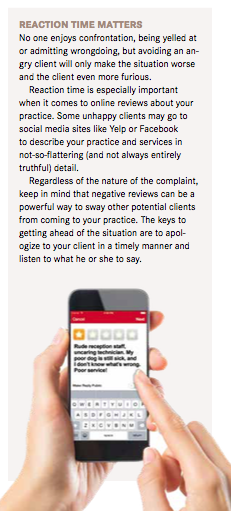From Mad to Glad: Appeasing Angry Clients
Unhappy customers are inevitable in any business. Here’s how to defuse the situation when one of your clients is seeing red.

Your team’s clinical skills, bedside manner and customer service capabilities are impeccable, yet a client has just entered your practice fuming. The fact is that every business deals with unhappy customers at some point. It's how you handle the situation that determines whether it will have a lasting effect on your practice’s overall success.
What you say and how you say it are the two most important things to consider when dealing with dissatisfied clients. While your first reaction may be defensiveness, it’s important to react proactively and professionally.
After bringing the client to a quiet area out of the flow of practice traffic, follow these tips for defusing the situation and moving forward.
RELATED:
- How to Deal with Bad Online Reviews
- For Clients Today, Convenience Is King

Allow the client to tell you everything he or she wants you to know about the issue. Don’t speak over the client, don’t let yourself get distracted and make sure you’re exhibiting the proper body language — don’t look angry, upset or standoffish. Consider the situation from the client’s point of view. You may not agree with the complaint, but empathy shows that you acknowledge and understand the client’s feelings.
Ask Questions
Once the client has finished speaking, summarize using a gentle tone of voice what he or she just told you. Knowing that his or her side of the story has been heard will set the tone for the rest of the conversation. Then, ask open-ended questions. “What do you think about that?” “Would it be possible for us to do this?” “What questions do you have for me?” Try not to place blame on the client or ask any questions that could be misconstrued.
Be Honest
There’s no way to get out of a sticky situation with an upset client unless you are completely honest and open. Even if your displeased client is the chronic complainer type, don’t disregard the possibility that he or she has a legitimate reason for complaining. If you know that you or another member of your team is at fault, take responsibility. By owning up to your mistakes, you can make amends and assure the client that the issue won’t happen again.
Don’t Just Apologize
Although an apology can go a long way toward pacifying an angry client, it’s better to go above and beyond. Offer the client some type of compensation, such as a free medication sample or a discount on the next visit. Make sure the client understands what steps you and your practice will take to make sure the problem is resolved. At the end of the conversation, make sure both parties feel good about the solution.
If All Else Fails, Cut Ties
Some clients simply can’t be mollified. If a client is inherently wrong, won’t admit it and won’t budge, there may be no other solution but to cut ties. With some clients, if things are spiraling out of control, you may want to gently suggest they seek another practice to care for their pet. You might both be better off in the end.
